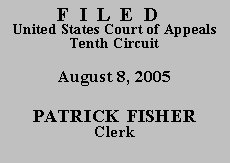 UNITED STATES COURT OF APPEALS
UNITED STATES COURT OF APPEALS
 UNITED STATES COURT OF APPEALS
UNITED STATES COURT OF APPEALS
TENTH CIRCUIT
UNITED STATES OF AMERICA,
Plaintiff - Appellee,
v.
PATRICK LAFAYETTE STEWART,
Defendant - Appellant.
Before EBEL, McKAY, and HENRY, Circuit Judges.
Defendant was charged in a two-count indictment for possession of a firearm after a felony conviction in violation of 18 U.S.C. § 922(g)(1) (Count I) and for possession of crack cocaine in violation of 21 U.S.C. § 844 (Count II). In a superseding indictment, prosecutors added Sentencing Guidelines enhancement language, which alleged that Defendant possessed the firearm in connection with a felony.
While running a routine license plate check on a maroon Chevrolet Malibu on May 17, 2004, officers from the Oklahoma City Police Department received information that the vehicle had been reported stolen. After learning this, the officers attempted to pull the vehicle over. This effort was unsuccessful, however, and a high speed chase ensued on Interstate 40 through the center of Oklahoma City. During the chase, Defendant swerved wildly and lost control of his vehicle, which became airborne and eventually crashed into a concrete median on the interstate. Undeterred by the collision, Defendant leaped out of the vehicle, threw his jacket over the side of the highway guardrail, and ran from pursuing officers. Eventually, after using a taser gun, the officers apprehended Defendant.
Officers also recovered the jacket Defendant discarded earlier in the chase. In the jacket's front pocket was a loaded .380 caliber, semi-automatic pistol and two plastic bags containing cocaine base. After being charged, Defendant pled guilty to Counts I and II of the superseding indictment.
At sentencing, the presentence report recommended that the district court apply a sentencing enhancement under § 2K2.1(b)(5) of the United States Sentencing Guidelines Manual (Guidelines) because Defendant allegedly possessed the firearm in connection with the felonious possession of crack cocaine. Defendant objected to the district court's application of § 2K2.1(b)(5) as violating his Sixth Amendment rights as articulated in Blakely v. Washington, 542 U.S. 296 (2004). Rec., Vol. III, at 3-4. The district court overruled Defendant's objection. Id. at 4. Defendant was subsequently sentenced to seventy-nine months' incarceration.
On appeal, Defendant challenges his sentence as being imposed in violation of his constitutional rights, as recently articulated by the Supreme Court in United States v. Booker, __U.S.__, 125 S. Ct. 738 (2005). Specifically, Defendant claims that the district court committed non-constitutional error when it applied the Guidelines in a mandatory fashion at sentencing. Because Defendant made a Blakely objection to the district court at sentencing, Defendant preserved his Booker argument for this appeal. See United States v. Labastida-Segura, 396 F.3d 1140, 1142-43 (10th Cir. 2005) (noting that a Blakely objection is sufficient to preserve a non-constitutional Booker error). Therefore, we will review for harmless error. Id.
Federal Rule of Criminal Procedure 52(a) provides that "[a]ny error, defect, irregularity, or variance that does not affect substantial rights must be disregarded." The Supreme Court has directed courts of appeals to remand cases for re-sentencing when the district court has misapplied the Guidelines unless the court of appeals concludes that the district court's selection of the sentence was not affected by the error, i.e., that the error was harmless. United States v. Riccardi, 405 F.3d 852, 875 (10th Cir. 2005) (citing Williams v. United States, 503 U.S. 193, 203 (1992)). In a harmless error case, such as this one, the government has the burden of demonstrating that Defendant's substantial rights were not affected, which does not require proof that the invalid factor was determinative in arriving at Defendant's sentence. Williams, 503 U.S. at 203.
In Labastida-Segura, we held that a sentence at the bottom of the Guidelines range demonstrates that the error is not harmless and warrants an automatic remand for re-sentencing. Labastida-Segura, 396 F.3d at 1143. That is not the case here. In this case, the district court, after reviewing the presentence report and applying the Guidelines enhancement, determined Defendant's Guidelines imprisonment range to be from seventy to eighty-seven months. After making this determination, the sentencing court decided to impose a sentence of seventy-nine months, in the middle of the Guidelines range. Based on this sentence, there is no reason to believe that the district court would have imposed a less severe sentence with its new post-Booker discretion. Riccardi, 405 F.3d at 876. The fact that the district court judge imposed a sentence not at the bottom of the Guidelines range indicates that there is no reasonable probability that the court would reduce Defendant's sentence on remand post-Booker. See id. ("Having exercised his limited discretion under the pre-Booker system to give [Defendant] the highest permissible sentence, there is no reason to think the judge would exercise his now-greater discretion to reduce the sentence."). Also, there are no remarks in the record which demonstrate that the seventy-nine-month sentence was inappropriate in light of all the circumstances. See id.
Accordingly, even though Defendant's sentence was imposed in violation of the Sixth Amendment standards set forth in Booker, the error did not violate Defendant's substantial rights and must be disregarded.
AFFIRMED.
Entered for the Court
Monroe G. McKay
Circuit Judge
*. This order and judgment is not binding precedent, except under the doctrines of law of the case, res judicata, and collateral estoppel. The court generally disfavors the citation of orders and judgments; nevertheless, an order and judgment may be cited under the terms and conditions of 10th Cir. R. 36.3.